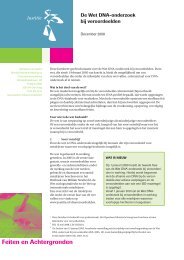INTERPOL HANDBOOK ON DNA DATA EXCHANGE AND PRACTICE
INTERPOL HANDBOOK ON DNA DATA EXCHANGE AND PRACTICE
INTERPOL HANDBOOK ON DNA DATA EXCHANGE AND PRACTICE
Create successful ePaper yourself
Turn your PDF publications into a flip-book with our unique Google optimized e-Paper software.
Regardless of which tests are applied to infer biogeographical ancestry (mt<strong>DNA</strong>,Y-chromosome or SNP-based tests) it is important to note that:1. These tests are designed as intelligence tools, operating as a preliminary screen thatshould reduce the range of possibilities and target investigations.2. Research is required to be undertaken at a local level in order to make accurateinferences of ethnicity. This is particularly so for multi-cultural, immigrant societieswith increased admixture and complex sub-structure that is largely regionallyspecific.•physical traitsResearch is occurring into genetic markers linked to physical or personal traits thatcould be relevant for forensic purposes. The aim is to provide investigators with aninferred description of an offender, based on biological evidence recovered from aparticular crime and subsequent <strong>DNA</strong> analysis. Research has predominantly focusedon genetic determinants of hair, skin and eye colour.In one of the first projects in this area researchers from the United Kingdom ForensicScience Service (FSS) described an approach to screen mutations in a gene associatedwith the red-hair phenotype (known as MC1R) 50 . Another gene involved in thebiological pathway governing human skin pigmentation is the agouti signalling protein(ASIP). Studies have shown that SNPs in the ASIP gene are associated with dark hair andbrown eyes in European Americans 51 and skin colour in African American females 52 .There is also significant research being directed toward determining human eye colour.These studies indicate that SNPs significantly associated with eye colour occur innumerous genes 53 . Therefore, no single gene could be used to make a reliable predictionabout eye colour.In addition to these forensic-specific developments, research from the genetics andmedical fields describe genetic associations with physical characteristics such asstature 54 and personal traits such as a smoking habit 55 .•potential socio-legal issuesIt is important to recognize that successful use of genetics in forensic science in theway that has been described in this section will require a paradigm shift in terms ofexpectations regarding the conclusiveness of the results. To date, the justice systemhas expressed a desire for <strong>DNA</strong>-based identifications to be as close to absolute aspossible, and in the public domain, <strong>DNA</strong> identifications are often regarded as scientificcertainty. Inferences drawn from predictive markers such as those described above willbe less definitive and will be of most value when used as intelligence to direct policeinvestigations, similar to an eye-witness or victim statement.GEOGRAPHICAL SEARCH, PHYLOGENY, PHYSICAL CHARACTERISTICS<strong>AND</strong> OTHER USESPAGE 81







